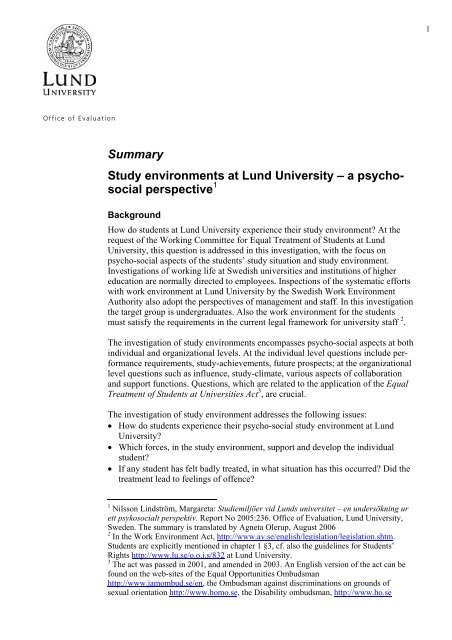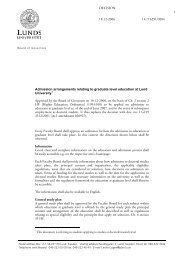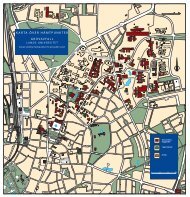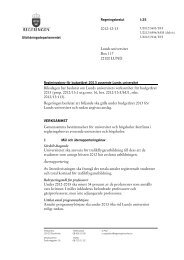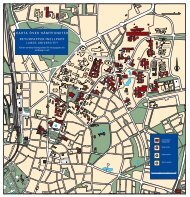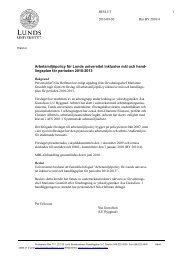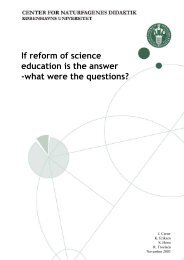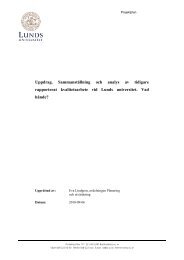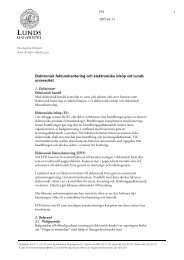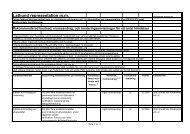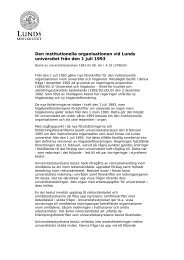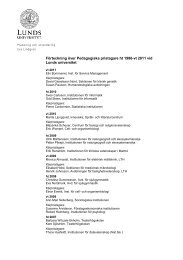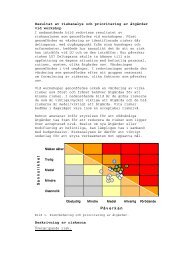Summary Study environments at Lund University ... - Lunds universitet
Summary Study environments at Lund University ... - Lunds universitet
Summary Study environments at Lund University ... - Lunds universitet
You also want an ePaper? Increase the reach of your titles
YUMPU automatically turns print PDFs into web optimized ePapers that Google loves.
1Office of Evalu<strong>at</strong>ion<strong>Summary</strong><strong>Study</strong> <strong>environments</strong> <strong>at</strong> <strong>Lund</strong> <strong>University</strong> – a psychosocialperspective 1BackgroundHow do students <strong>at</strong> <strong>Lund</strong> <strong>University</strong> experience their study environment? At therequest of the Working Committee for Equal Tre<strong>at</strong>ment of Students <strong>at</strong> <strong>Lund</strong><strong>University</strong>, this question is addressed in this investig<strong>at</strong>ion, with the focus onpsycho-social aspects of the students’ study situ<strong>at</strong>ion and study environment.Investig<strong>at</strong>ions of working life <strong>at</strong> Swedish universities and institutions of highereduc<strong>at</strong>ion are normally directed to employees. Inspections of the system<strong>at</strong>ic effortswith work environment <strong>at</strong> <strong>Lund</strong> <strong>University</strong> by the Swedish Work EnvironmentAuthority also adopt the perspectives of management and staff. In this investig<strong>at</strong>ionthe target group is undergradu<strong>at</strong>es. Also the work environment for the studentsmust s<strong>at</strong>isfy the requirements in the current legal framework for university staff 2 .The investig<strong>at</strong>ion of study <strong>environments</strong> encompasses psycho-social aspects <strong>at</strong> bothindividual and organiz<strong>at</strong>ional levels. At the individual level questions include performancerequirements, study-achievements, future prospects; <strong>at</strong> the organiz<strong>at</strong>ionallevel questions such as influence, study-clim<strong>at</strong>e, various aspects of collabor<strong>at</strong>ionand support functions. Questions, which are rel<strong>at</strong>ed to the applic<strong>at</strong>ion of the EqualTre<strong>at</strong>ment of Students <strong>at</strong> Universities Act 3 , are crucial.The investig<strong>at</strong>ion of study environment addresses the following issues:• How do students experience their psycho-social study environment <strong>at</strong> <strong>Lund</strong><strong>University</strong>?• Which forces, in the study environment, support and develop the individualstudent?• If any student has felt badly tre<strong>at</strong>ed, in wh<strong>at</strong> situ<strong>at</strong>ion has this occurred? Did thetre<strong>at</strong>ment lead to feelings of offence?1 Nilsson Lindström, Margareta: Studiemiljöer vid <strong>Lund</strong>s <strong>universitet</strong> – en undersökning urett psykosocialt perspektiv. Report No 2005:236. Office of Evalu<strong>at</strong>ion, <strong>Lund</strong> <strong>University</strong>,Sweden. The summary is transl<strong>at</strong>ed by Agneta Olerup, August 20062 In the Work Environment Act, http://www.av.se/english/legisl<strong>at</strong>ion/legisl<strong>at</strong>ion.shtm.Students are explicitly mentioned in chapter 1 §3, cf. also the guidelines for Students’Rights http://www.lu.se/o.o.i.s/832 <strong>at</strong> <strong>Lund</strong> <strong>University</strong>.3 The act was passed in 2001, and amended in 2003. An English version of the act can befound on the web-sites of the Equal Opportunities Ombudsmanhttp://www.jamombud.se/en, the Ombudsman against discrimin<strong>at</strong>ions on grounds ofsexual orient<strong>at</strong>ion http://www.homo.se, the Disability ombudsman, http://www.ho.se
Work environment questions have been central in the student s<strong>at</strong>isfaction surveyscarried out for each faculty <strong>at</strong> <strong>Lund</strong> <strong>University</strong>. Since the s<strong>at</strong>isfaction surveysinclude questions brought up by the students <strong>at</strong> each faculty, questions about workenvironment are more or less prominent. The Student barometer 2000 4 and threerecent student s<strong>at</strong>isfaction surveys 5 (in Humanities, Social Sciences and N<strong>at</strong>uralScience) include questions about weekly working time, benefits from and influenceon the studies as well as the physical work environment. These investig<strong>at</strong>ionsprovide an interesting reference m<strong>at</strong>erial for this inquiry into study <strong>environments</strong>.2During the last years a number of investig<strong>at</strong>ions rel<strong>at</strong>ed to the Equal Tre<strong>at</strong>ment Acthave been carried out by the Office of Evalu<strong>at</strong>ion <strong>at</strong> <strong>Lund</strong> <strong>University</strong> 6 . The findingsfrom these investig<strong>at</strong>ions showed th<strong>at</strong> students with disabilities as a rule weres<strong>at</strong>isfied with the facilities for support they have access to. On the other hand theyconsidered th<strong>at</strong> the university, <strong>at</strong> central and departmental levels, should work morepreventively with regard to counteracting offensive and discrimin<strong>at</strong>ing tre<strong>at</strong>ment inclass. According to an interview-study with homo- and bisexual students there isa compact standard of hetero-norm<strong>at</strong>ivity within the university. Expressing adifferent sexual identity means th<strong>at</strong> the student runs the risk of becoming excludedfrom the social community.Popul<strong>at</strong>ion and sampleThe popul<strong>at</strong>ion for this investig<strong>at</strong>ion consists of undergradu<strong>at</strong>es who are registeredfor courses of <strong>at</strong> least 10 credit points (equivalent to 15 ECTS). From this popul<strong>at</strong>ion,of around 20 000 students, a random sample of 4000 students (about 20 % ofthe popul<strong>at</strong>ion) was taken. The sample includes students representing all facultiesor schools within <strong>Lund</strong> <strong>University</strong>. Slightly more than 2000 students (about 53% ofthe sample) particip<strong>at</strong>ed in the investig<strong>at</strong>ion, but the response r<strong>at</strong>es vary amongfaculties.Theoretical frame of referenceThe framework chosen to investig<strong>at</strong>e the study environment has been adopted fromthe demand-control model (Karasek & Theorell 1990), which focuses on factors ofimportance for how specific individuals experience the psycho-social work situ<strong>at</strong>ion.This model, which has been used as a theoretical frame of reference in severalstudies of work environment, is here applied to the students’ experiences of theuniversity environment 7 . Taking the variables psychological demands and decisionl<strong>at</strong>itude as starting points the model identifies four types of work situ<strong>at</strong>ions: i.e. highstrain,low-strain, active and passive work. It is a characteristic of high-strain work4 Studentbarometer 2000, Report 2000:299, Office of Evalu<strong>at</strong>ion, contains a summary inEnglish5 Summaries of the Student s<strong>at</strong>isfaction surveys are available, http://www.lu.se/evalu<strong>at</strong>eng6 Undersökningar kring lagen om Likabehandling av studenter (Investig<strong>at</strong>ions around theEqual Tre<strong>at</strong>ment of Students Act), http://www.evalu<strong>at</strong>.lu.se7 The concept of psycho-social factors in the work environment is hard to delimit and mayinclude physical as well as social and organiz<strong>at</strong>ional environmental factors. Also the conceptof study situ<strong>at</strong>ion is elusive since it means an interchange between conditions withinand outside the studies. In this investig<strong>at</strong>ion the selection of psycho-social factors is foundedon interviews particularly with student represent<strong>at</strong>ives about psycho-social conditions inteaching and activities closely rel<strong>at</strong>ed to teaching.
th<strong>at</strong> the individual experiences high psychological demands combined with littledecision l<strong>at</strong>itude with regard to influencing the work process by oneself. It is aboveall this situ<strong>at</strong>ion which in the end increases the risk for stress-rel<strong>at</strong>ed illnesses. Activework is also characterized by high psychological demand but this is combined withexperiences of having own action and decision l<strong>at</strong>itude. Low psychological demandscombined with large influence over work means a low-strain work situ<strong>at</strong>ion. Passivework is characterized by low psychological demands combined with little decisionl<strong>at</strong>itude and can be found, for example, in work <strong>at</strong> the conveyor belt.3Taking the theoretical model above as a starting point a questionnaire was prepared.From the questions about study situ<strong>at</strong>ion and study environment five differentindexes were constructed. The index of psychological demands includes questionsabout weekly working time, workload in the studies, total workload, level of difficultyof the studies, previous knowledge required, study achievements and selfstudies.The index of decision l<strong>at</strong>itude is composed of questions about the clarity ofrequirements on study achievements and inform<strong>at</strong>ion about the goal of the studyprogram or course, design, contents, liter<strong>at</strong>ure, schedules, examin<strong>at</strong>ion and assessment.In order to further elucid<strong>at</strong>e the l<strong>at</strong>itude-dimension this index is in the analysissupplemented with questions about influence on the contents of the studies as well asthe possibilities for planning one’s own time. To distinguish between aspects of timeand contents, control over and control in work, is essential with regard to the students’assessment of decision l<strong>at</strong>itude. The lack of decision l<strong>at</strong>itude is in studentsurveys often expressed as the lack of influence over the design and contents of thestudies.It is important to combine the demand-control model with the dimension of socialsupport (Karasek & Theorell 1990, Theorell 2003). Social support may act as abuffer with regard to allevi<strong>at</strong>ing effects of a high-strain situ<strong>at</strong>ion. The socialsupport, including practical as well as emotional help, is rel<strong>at</strong>ed to persons in thestudy programme, in the family as well as among friends and acquaintances.Furthermore the students’ contacts with the various service-activities of the universityprovide part of the social network surrounding the individual student. Thesocial support is elucid<strong>at</strong>ed by two indices, i.e. support in teaching and supportfrom fellow students. The index on support in teaching is composed of questionsabout feedback during the course and in connection with examin<strong>at</strong>ion, and to wh<strong>at</strong>extent the study clim<strong>at</strong>e is characterized by appreci<strong>at</strong>ion and praise, a high degreeof freedom of opinion, being respectfully tre<strong>at</strong>ed and receiving responses on studywork.The index on support from fellow students includes questions about to wh<strong>at</strong>extent the study clim<strong>at</strong>e among fellow students is characterized by collabor<strong>at</strong>ion,security, solidarity, tolerance and respect.The students’ own assessment of the level of stress of the studies is provided by afifth index, the stress-index. This encompasses questions about to wh<strong>at</strong> extent thestudy requirements are stressing and to wh<strong>at</strong> extent the study environment ischaracterized by high achievement demands, exam nerves, competition and stress.This index has also been used as an indic<strong>at</strong>or of the applicability of the demandcontrolmodel, in other words to wh<strong>at</strong> extent the other indices actually provide aninsight into how the psycho-social study situ<strong>at</strong>ion and environment are shaping.
Findings and conclusionsThe highest study demands come from the students themselves. This is how themajority of the students in this investig<strong>at</strong>ion of the study environment describe theirstudies <strong>at</strong> <strong>Lund</strong> <strong>University</strong>. In second place the demands from the labour market areemphasized and only in third place the requirements of the educ<strong>at</strong>ion as they arecommunic<strong>at</strong>ed by teachers and supervisors. The investig<strong>at</strong>ion gives the picture ofthe existentially lonely student with high demands on him-/herself. A far-reachingindividualism often characterizes how students and university staff explain whysome students show signs of stress; they were overambitious and achievementorientedalready before they began their university studies. Thus problem<strong>at</strong>iz<strong>at</strong>ionoccurs primarily <strong>at</strong> the individual level. This investig<strong>at</strong>ion shows, however, th<strong>at</strong>there are also reasons to look for explan<strong>at</strong>ions within the study environment of thevarious faculties of the university.4The students’ assessments of their study environment vary considerably amongstudy programmes. The study programme in Law has the highest proportion ofstudents experiencing a stressful study situ<strong>at</strong>ion. High demands from the labourmarket of lawyers in combin<strong>at</strong>ion with weak support from teachers and supervisorsare probably the primary reasons. An interesting comparison is provided by thedescriptions of the study situ<strong>at</strong>ion <strong>at</strong> Malmö Academies of Performing Arts. Withinthe programmes of Art, Music and The<strong>at</strong>re the study requirements are perceived as<strong>at</strong> least equally high, but there is a considerably smaller share of the studentsexperiencing the educ<strong>at</strong>ion as stressful. These programmes are characterized by thestrong support the students receive in class.Fairly high levels of psychological demands are also characteristic for the studysitu<strong>at</strong>ion <strong>at</strong> <strong>Lund</strong> Institute of Technology (LTH), but the proportion of studentssuffering from stress are considerably fewer than within the study programme inLaw. An exception is the programme oriented towards Industrial Economics. As forthe rest of the engineering study programmes strain is compens<strong>at</strong>ed by a strongsupport among fellow students, <strong>at</strong> least for the majority of male students. Womenstudents report higher levels of study demands and higher strain. Within the studyprogrammes of Medicine and Care students also report high levels of demand,particularly within the programmes in Physiotherapy, Speech P<strong>at</strong>hology andTherapy as well as Medicine. For the majority within this area, as within LTH, ahigh level of support among fellow students is as a rule conducive towardsreducing levels of strain.Within the programmes <strong>at</strong> the Faculty of Science as well as <strong>at</strong> <strong>Lund</strong> <strong>University</strong>School of Economics and Management (LUSEM) students as a rule assess thestudy demands as moder<strong>at</strong>ely high. A higher level of decision l<strong>at</strong>itude is characteristicfor students in N<strong>at</strong>ural Sciences. The N<strong>at</strong>ural Science students also report th<strong>at</strong>there is a well-functioning support among fellow students. All in all this probablycounteracts strain. Within the programmes <strong>at</strong> LUSEM the students’ experiences aredifferent. Above all female students experience the study situ<strong>at</strong>ion as stressful.Students <strong>at</strong> LUSEM, just as the Law students, perceive above all the support fromteaching but also th<strong>at</strong> among fellow students as weaker than students within otherprogrammes do.Within programmes in the Social Sciences, Humanities and Theology most studentsreport somewh<strong>at</strong> lower levels of demands and less strain in the study situ<strong>at</strong>ion.Within the Social Science educ<strong>at</strong>ions the students describe the study situ<strong>at</strong>ion in the
programme of Master in Political Studies and in the subject of Media- and Communic<strong>at</strong>ionStudies as slightly more stressful than do students in other SocialScience study programmes. The levels of stress are lower in Humanities andTheology. These educ<strong>at</strong>ions are characterized by low levels of demands combinedwith fairly weak support from fellow students. An exception is female students inTheology who give the support among fellow students much higher marks thanmale students do. This support is an important buffer against strain. Most studentsin this investig<strong>at</strong>ion assess the possibilities for decision l<strong>at</strong>itude as constrained andlimited. The inform<strong>at</strong>ion they have about the design and contents of the educ<strong>at</strong>iondoes not as a rule make it possible to make a time-oriented plan encompassing awhole semester. Another import aspect of control is the influence on the contents ofthe studies, which is perceived as constrained and limited. The students assess thesupport they receive during teaching as insufficient, for example in terms of feedbackduring the progress of the course and in connection with exams. In theStudentbarometer 2000 it was st<strong>at</strong>ed th<strong>at</strong> it was problem<strong>at</strong>ic to take any measureswith regard to the students’ diss<strong>at</strong>isfaction with the response on study-achievements,since the university was in a situ<strong>at</strong>ion of financial reductions. From afinancial perspective the situ<strong>at</strong>ion is hardly less problem<strong>at</strong>ic today! The combin<strong>at</strong>ionof limited possibilities for decision l<strong>at</strong>itude and support in teaching is howevera considerable risk-factor, according to the demand-control model for workenvironment analyses applied in this investig<strong>at</strong>ion. Despite this the majority ofstudents don’t experience their situ<strong>at</strong>ion as particularly stressful. This is probablydue to the fact th<strong>at</strong> they perceive the study demands as reasonable and th<strong>at</strong> thesupport among fellow students is strong. Most students also give high marks to thetre<strong>at</strong>ment they receive in class. According to the students’ judgments, the studentsin the N<strong>at</strong>ural Science programmes and <strong>at</strong> the Malmö Academies of PerformingArts receive the best tre<strong>at</strong>ment. Within the Law programme and in some respectwithin LUSEM the tre<strong>at</strong>ment is given poorer marks. This may be connected withth<strong>at</strong> students in these educ<strong>at</strong>ions assess both the support they receive in teachingand from fellow students as weaker than other students do.5An essential part of the investig<strong>at</strong>ion of study <strong>environments</strong> are issues rel<strong>at</strong>ed to theEqual Tre<strong>at</strong>ment of Students Act. The findings demonstr<strong>at</strong>e th<strong>at</strong> a fifth of the studentshave experienced being badly tre<strong>at</strong>ed during their studies. The majority arewomen from academic backgrounds. They are a few years older than the average.The age-group 26-34 years has the highest proportion of students, who have beenbadly tre<strong>at</strong>ed. They devote rel<strong>at</strong>ively more time to their studies and most of themhave achieved more than 80 credits (120 ECTS). Thus the students who haveneg<strong>at</strong>ive experiences are as a rule women with high ambitions and with severalyears’ of experience in the university environment. Some students, more precisely6% of those particip<strong>at</strong>ing in the investig<strong>at</strong>ion, have perceived the tre<strong>at</strong>ment as beingso bad th<strong>at</strong> they have taken offence. This is equivalent to slightly more than 1000students in the popul<strong>at</strong>ion as a whole. The offending situ<strong>at</strong>ions the studentsdescribe often indic<strong>at</strong>e complex situ<strong>at</strong>ions and rel<strong>at</strong>ions in class. Only a smallnumber of cases have been judged as serious offences.Among the motives mentioned in the Equal Tre<strong>at</strong>ment of Students <strong>at</strong> UniversitiesAct gender is the most frequent reason for offensive actions. Most of the offendedstudents are female within traditionally male-domin<strong>at</strong>ed study programmes, forexample in the engineering area, but also in women domin<strong>at</strong>ed programmes asPsychology and Theology. Those who have experienced offence due to their ethnicbackground are somewh<strong>at</strong> overrepresented among students with a different ethnic
ackground than Swedish. Among those who have felt offended due to their sexualorient<strong>at</strong>ion only a few have described the situ<strong>at</strong>ion they have been exposed to in theopen question of the questionnaire. This supports the findings from a previousinterview-study about homo- and bisexual students’ experiences of the silence ofthe heterosexual standard which surrounds the situ<strong>at</strong>ion of these students 8 . Somedisabled students have experiences of limited accessibility to some educ<strong>at</strong>ions andthe limited knowledge and out-of-d<strong>at</strong>e views on issues of disability among university-staff.These findings correspond with the findings in a previous investig<strong>at</strong>ion ofstudents with disabilities (Nilsson Lindström 2003). Among those who have feltoffended, however, half have provided other reasons than those brought up in thetext of the act, reasons such social background and age. Most common are, however,th<strong>at</strong> the students refer to personal circumstances or characteristics as reasonsfor feeling uncomfortable <strong>at</strong> the university, such as personal style, views, uns<strong>at</strong>isfactorystudy achievements. Thus the tre<strong>at</strong>ment is considered as an individualproblem r<strong>at</strong>her than as expression for neg<strong>at</strong>ive tre<strong>at</strong>ment or discrimin<strong>at</strong>ion directedtowards a specific group. This is clear not only from the causes for offencesindic<strong>at</strong>ed but also in the ways of handling an offending situ<strong>at</strong>ion. The university’ssupport activities – such as the Student Health Service and the Services forStudents with Disabilities – are well-known and appreci<strong>at</strong>ed by many students, butmost who feel badly tre<strong>at</strong>ed look for support outside the university, in the socialnetwork of family and friends. It is also a common str<strong>at</strong>egy trying to avoid theperson or situ<strong>at</strong>ion causing the offence. Few students make demands either on thoseresponsible for the educ<strong>at</strong>ion or on the central officials in charge of these issues.6How the study situ<strong>at</strong>ion turns out is thus perceived by most students as mainly anindividual project. In order to moder<strong>at</strong>e the students’ far-reaching individualiz<strong>at</strong>ionof study-issues, this investig<strong>at</strong>ion has focussed on aspects of psychologicaldemands, decision l<strong>at</strong>ency and social support which are common to students withinspecific study programmes. More than 2000 students have particip<strong>at</strong>ed, in additionto student represent<strong>at</strong>ives in reference groups. By sharing their experiences theyhave contributed with a rich found<strong>at</strong>ion for the work with study environment ingeneral as well as for issues of equality and equal tre<strong>at</strong>ment in particular. From anequality perspective the main finding of the investig<strong>at</strong>ion is alarming: one out ofthree students experience their study situ<strong>at</strong>ion as high-strained. Three quarters ofthose are women in study programmes.8 Största möjliga tystnad. Report No 2004:226, Office of Evalu<strong>at</strong>ion, <strong>Lund</strong> <strong>University</strong>


